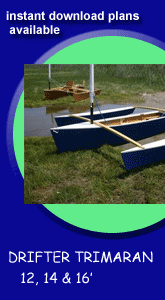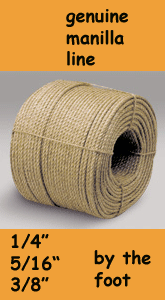
 Custom Search
|
| boat plans |
| canoe/kayak |
| electrical |
| epoxy/supplies |
| fasteners |
| gear |
| gift certificates |
| hardware |
| hatches/deckplates |
| media |
| paint/varnish |
| rope/line |
| rowing/sculling |
| sailmaking |
| sails |
| tools |
| join |
| home |
| indexes |
| classifieds |
| calendar |
| archives |
| about |
| links |
| Join Duckworks Get free newsletter CLICK HERE |
|
|
| Building 60 Grit - Part One |
by Larry Appelbaum - St. Louis, Missouri - USA |
Part One - Part TwoAuthor’s Note: I built 60 Grit during 1994 through 1996, thus the pre-digital photos. I scanned and touched-up the photos and wrote the article in 2009, but didn’t finish editing it until now in 2015. My *ultimate goal* was a 20 to 25 foot shoal-draft coastal cruising boat, such as Karl Stambaugh's Mist, at 20 feet, or Reuel Parker's Terrapin 25. A boat that would be somewhat trailerable to Midwest Messabouts or Florida two or three times per year, but otherwise kept in a marina on a local lake or kept in the backyard at home to work on over the winter. I had been day sailing my *first boat*, a Bolger/Payson Cartopper, for a few years, and really wanted a cruising boat. I really enjoy being on the water in the early morning and evening, just relaxing watching the birds, and not having to do anything or go anywhere else. I also like sailing around in the morning before the chop from the powerboats gets too thick and the sun too hot, then anchoring and relaxing for the rest of the day. From Friday after work to Saturday afternoon or evening is a common cruise for me. So my *next step* was a 14 to 16 foot micro-cruiser, like a West Wight Potter 14 or a Compac 16 in a production boat. (I wasn't aware of the Montgomery 15 at the time.) Something to be easily trailered and launched, and kept in the garage at home for the time being. But of course I wanted to build my own boat even more than sail it, so Glen-L's Minuet, Sam Devlin's Nancy's China, both burdensome 15-footers, and the Norwalk Islands Sharpie 18 were the finalists. (I don't remember Jim Michalak's Frolic 2 being available at the time.) The smallest, and I think the prettiest, of the three designs I was considering was the Nancy's China. I really wanted a boat with a yacht-like appearance, but was also seriously concerned about sufficient accommodations in the cabin. I had been able to climb inside a Compac 16 at a local dealer. It was yachty-looking, but the cabin, with only quarter berths and a spot for a cooler, was pretty tight. The answer came when I was able to climb into the cabin of Tom Grime's West Wight Potter at the Lake Monroe, Indiana, Midwest Messabout one year. "This is big enough!"
The key to the Potter's arrangements was the split vee berth in a fairly tall cabin. Of course I could lay down, as in the Compac, but I could also sit up comfortably, and there was room on the opposite vee berth to set up my backpacking stove and boil water for oatmeal and coffee. So the Nancy's China it would be. Overall it is slightly larger than the Potter, and the cabin is not as tall, but it would have plenty of space for me, Kingston (my new dog), and my camping gear. There were some mistakes made along the way, and also some good decisions. I ordered the plans from Devlin, which included a draft copy of part of his not-yet-published book, as a building manual. This was my second boat, and the construction method was somewhat different from the Cartopper. When Devlin's book became available and I finally read it, I realized it would have been a big help to have had it at the beginning. I knew nothing about boatbuilding when I built the Cartopper in 1990. The process went like this: I remembered studying boat plans like the Tahiti II in Mechanix Illustrated when I was a child or teenager, so twenty years later, I go to the public library near my old grade school, ask for the Mechanix Illustrated microfilm from somewhere in the 1970's, spool it up on the reader, and start flashing by so much stuff I remembered from so long ago.
I really had to concentrate on the ads in the back of each issue, or I could have been there for days. So I found Glen-L, Ken Hankinson, and Clark Craft. I wrote them, received their brochures, and a few dollars and a few more weeks later, had catalogs from all three. I also found WoodenBoat magazine somewhere, and Payson had a small ad in the back of it. So I wrote and got his catalog for a few more dollars and a few more weeks. I was really interested in a micro-cruiser in the first place, but my wife and I finally found a house to buy, so I had to decide on a design so I would be ready to start building the boat when we moved in. The house had a two car garage which would be all mine; she was very grateful that we had moved back to our hometown. The original purpose of the house idea was to have a back yard for Kingston, but the boatbuilding idea came along while we had been living in the apartment.
I had taken up canoeing while living in upstate New York near the Catskill Mountains, and started canoeing around the St. Louis, Missouri, area when we moved back. As I was paddling my 14-foot Royalex Old Town Canoe across Horseshoe Lake, Illinois, one hot sunny day, the thought came to me, "I could be sailing across here." I had briefly considered building a canoe back in New York, but now I became serious. I really liked the stitch-and-glue designs much more than the older 1950's designs in the catalogs, and was already looking at the Nancy's China, which was in Hankinson's catalog. But I decided to go with smaller and simpler than I wanted for now, and ordered the Cartopper plans. This was a very good decision. From all the reading I had been doing, I knew how little I knew about how to actually build a boat, so I also ordered Payson's book, "Building the New Instant Boats". I followed Bolger's plans and Payson's book religiously, and the construction turned out very well. There were a couple problems where I took some shortcuts, later corrected, and learning to sail was much harder than I thought it would be, but was eventually accomplished. The Cartopper was *very* seaworthy. I was put off by its tenderness and unreefable sail the first few years I was learning to sail, but then I started carrying a trolling motor battery and 4 gallons of sand for ballast. That set her down on her lines with me and Kingston aboard, and she was much more solid at a normal angle of heel. I also added a row of reef points to the boomless spritsail, but never really used them, having learned to depower the sail using the snotter and sheet with a stiff mast and sprit.
A bad shortcut I took on the Cartopper was using PVC pipe at first for the mast and sprit. It was cheap, easy to work with, not too heavy, but boy did it flex in a breeze. It was fine for light airs, but the sail always became parachute-shaped when the wind picked up. This was solved cheaply and easily by using a 10-foot piece of stair railing stock and a 10-foot closet pole for the new mast and boom. The sailing stability of the ballast was the main reason I wanted a heavier boat at the time I was selecting a micro-cruiser design, not just for the cruising accommodations. But since sailing a lot more, and canoeing and kayaking in a lot of choppy water, I think I would be more comfortable with a lighter sailboat now. For the Cartopper's hull, I had used the high quality, waterproof, 5mm luan plywood that was commonly available at the time for less than $10 per sheet. I used System Three epoxy and fiberglass, and had no problems with it. So for the Nancy's China, I was able to obtain some nice marine-grade fir plywood locally at a good price to build the hull. This also resulted in a strong, durable hull, but was not a good decision. I was still trying to buy everything I could locally, as I had with the Cartopper. But after completing the bare hull with the fir plywood, I decided I better glass the inside also to keep the plywood from checking, as I had been reading about. This cost a lot of extra time, money and weight, and was necessary at that point. But it would have been much better to order the expensive okoume for the hull, pay the high shipping cost, and wait a few more weeks for it to arrive.
To be continued... |
To comment on Duckworks articles, please visit one of the following:
|
 |

















